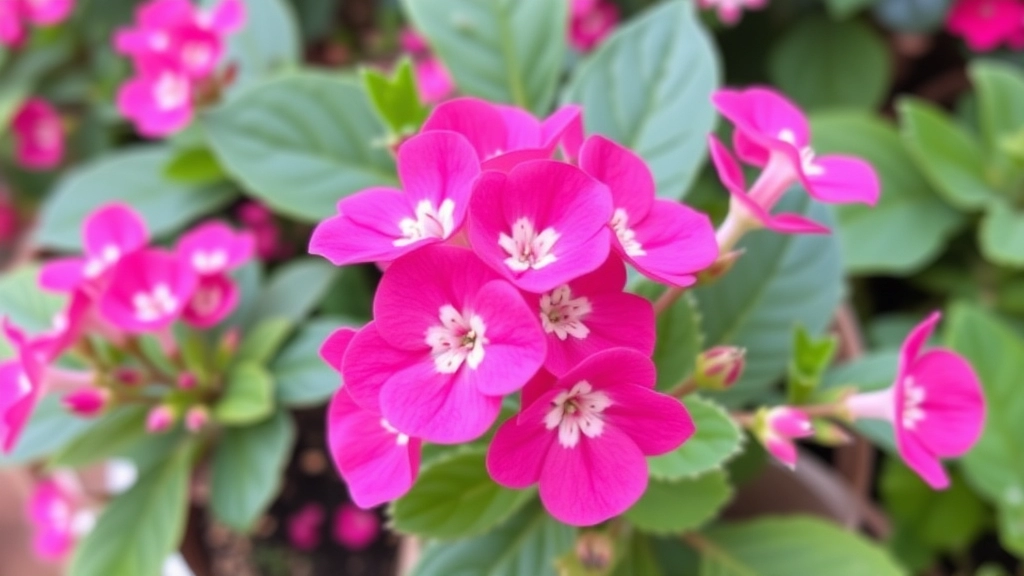Adding Vibrant Colour to Your Indoor Garden
Looking to add a splash of vibrant colour to your indoor garden? The Hot Pink Kalanchoe might just be the perfect choice. This stunning variety of Kalanchoe blossfeldiana not only brightens up any space with its vivid blooms but is also relatively easy to care for. In this guide, I’ll walk you through everything you need to know about growing and maintaining this beautiful succulent.
Best Growing Conditions
First things first, let’s talk about the best growing conditions for your Hot Pink Kalanchoe. These plants thrive in bright, indirect light and prefer a well-draining soil mix. Keep an eye on the temperature, as they do best in a range of 15-25°C. With the right care, your Kalanchoe will reward you with prolonged flowering, making it a standout addition to your home décor.
When it comes to caring for your Hot Pink Kalanchoe, you may find yourself wondering about the best practices to ensure vibrant blooms and healthy growth. This guide is here to walk you through the essentials of keeping your Kalanchoe thriving, whether you’re a seasoned plant parent or new to succulents.
### Understanding Your Kalanchoe
Hot Pink Kalanchoe, known for its stunning clusters of bright pink flowers, thrives with the right care. Here’s what you need to know:
#### Key Care Tips:
– **Light Requirements**: Kalanchoes love bright, indirect sunlight. Too little light can hinder blooming, while direct sunlight may scorch the leaves.
– **Watering**: It’s crucial to let the soil dry out between waterings. Overwatering can lead to root rot.
– **Temperature**: Aim for a comfortable indoor temperature, ideally between 18°C to 24°C (65°F to 75°F).
– **Soil**: Use well-draining soil, such as a cactus mix, to keep your plant healthy.
– **Fertilization**: Feed your Kalanchoe with a balanced, water-soluble fertiliser every few weeks during the growing season to encourage blooming.
#### Common Concerns:
Many plant owners worry about pests or diseases. Keep an eye out for mealybugs and aphids, as well as signs of overwatering like yellowing leaves. If you’re dealing with issues like leaf discoloration, you might find our guide on [why are my Kalanchoe leaves turning red](https://planthq.org/why-are-my-kalanchoe-leaves-turning-red-causes-solutions/) helpful. Additionally, for those interested in propagation techniques, check out our [Kalanchoe stem propagation guide](https://planthq.org/kalanchoe-stem-propagation-stepbystep-guide/).
Best Growing Conditions for Kalanchoe Indoors
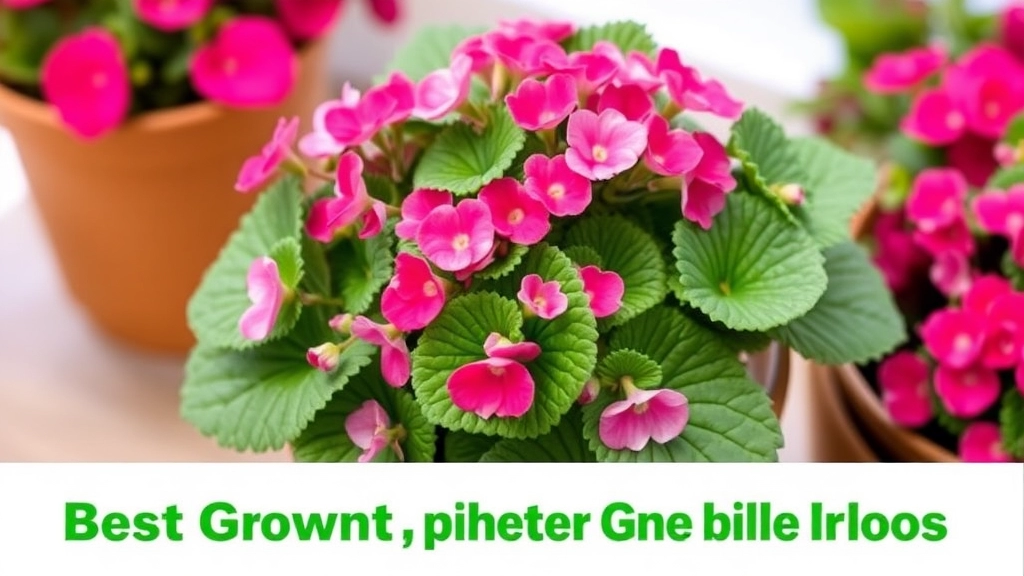
So, you’ve got your eye on a Hot Pink Kalanchoe, and you’re wondering how to keep it thriving indoors.
First off, let’s talk about the basics. Kalanchoe plants are pretty forgiving, but they do have their preferences. Here’s what you need to create the perfect environment for your blooming beauty:
- Light: These plants love bright, indirect light. A spot near a window that gets plenty of sunlight is ideal. If you notice the leaves stretching out, it’s a sign they’re not getting enough light.
- Temperature: Kalanchoe thrives in temperatures between 15°C and 25°C. Avoid placing them near drafts or heating vents. They can be a bit fussy about sudden temperature changes.
- Humidity: Kalanchoe prefers dry air. So, if you live in a humid area, make sure your plant has good air circulation.
- Airflow: Good airflow is essential. This helps prevent diseases and encourages healthy growth.
Now, let’s not forget about the potting situation. Kalanchoe needs a well-draining pot. A terracotta pot works wonders as it allows excess moisture to escape.
When it comes to keeping your Hot Pink Kalanchoe thriving, understanding its light and temperature needs is crucial. You might wonder why your plant is not blooming as expected or why its leaves are dropping. The right conditions can make all the difference.
Hot Pink Kalanchoe loves bright, indirect sunlight. Here’s what you need to know:
– **Direct Sunlight**: Avoid placing your plant in harsh, direct sunlight for extended periods, as this can scorch the leaves.
– **Ideal Location**: A south or west-facing window is usually perfect. If you notice the leaves stretching, it’s a sign your plant needs more light.
– **Supplemental Light**: If natural light is limited, consider using grow lights for about 12-14 hours a day.
Temperature plays a significant role in the health of your Kalanchoe. Here are some key points:
– **Optimal Range**: Keep your plant in a temperature range of 18-24°C (65-75°F). This is when it will flourish.
– **Avoid Extremes**: Protect your Kalanchoe from drafts and sudden temperature changes. Cold temperatures below 10°C (50°F) can be detrimental.
– **Humidity Levels**: Kalanchoe prefers lower humidity, making it well-suited for most indoor environments.
If you are looking for more detailed care tips, you might find this [ultimate guide to growing and caring for succulent plant Kalanchoe](https://planthq.org/ultimate-guide-to-growing-and-caring-for-succulent-plant-kalanchoe/) helpful. Additionally, if your Kalanchoe is not blooming, check out these [proven tips to get your Kalanchoe to bloom again](https://planthq.org/proven-tips-to-get-your-kalanchoe-to-bloom-again/).
How Often to Water a Kalanchoe
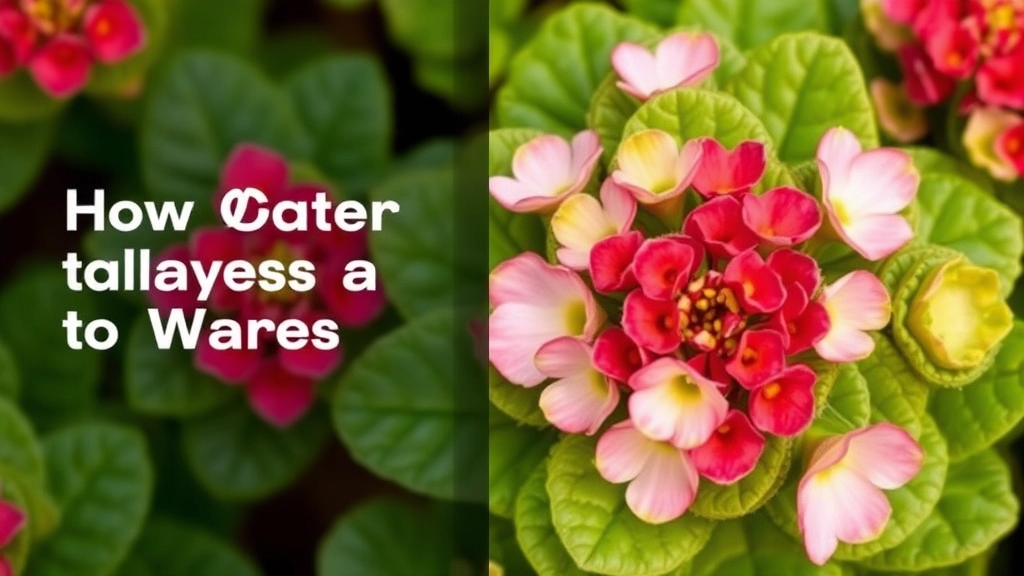
One of the most common questions I encounter is, “How often should I water my Kalanchoe?”
Getting the watering schedule right is crucial for the health of your Hot Pink Kalanchoe.
Key Watering Guidelines:
- Frequency: Water your Kalanchoe every two to three weeks. However, this can vary based on the season and environment.
- Soil Check: Always check the top inch of the soil. If it’s dry, it’s time to water. If it’s still moist, wait a few more days.
- Watering Technique: Water thoroughly until it drains from the bottom of the pot. This ensures the roots are adequately hydrated.
- Avoid Overwatering: Kalanchoes are succulents and store water in their leaves. Overwatering can lead to root rot, a common issue for many plant owners.
Seasonal Adjustments:
- Spring and Summer: During the growing season, you may need to water more frequently, about once a week, depending on humidity levels.
- Autumn and Winter: Reduce watering to once every three weeks, as the plant enters dormancy and requires less moisture.
Fertilization Tips for Prolonged Flowering
As we delve into the essentials of caring for your Hot Pink Kalanchoe, fertilization plays a pivotal role in ensuring your plant thrives and continues to bloom beautifully.
Understanding the Need for Fertilization
Are you wondering how to keep those vibrant pink flowers coming back year after year? Proper fertilization can make a significant difference.
Common Pests and Diseases of Hot Pink Kalanchoe
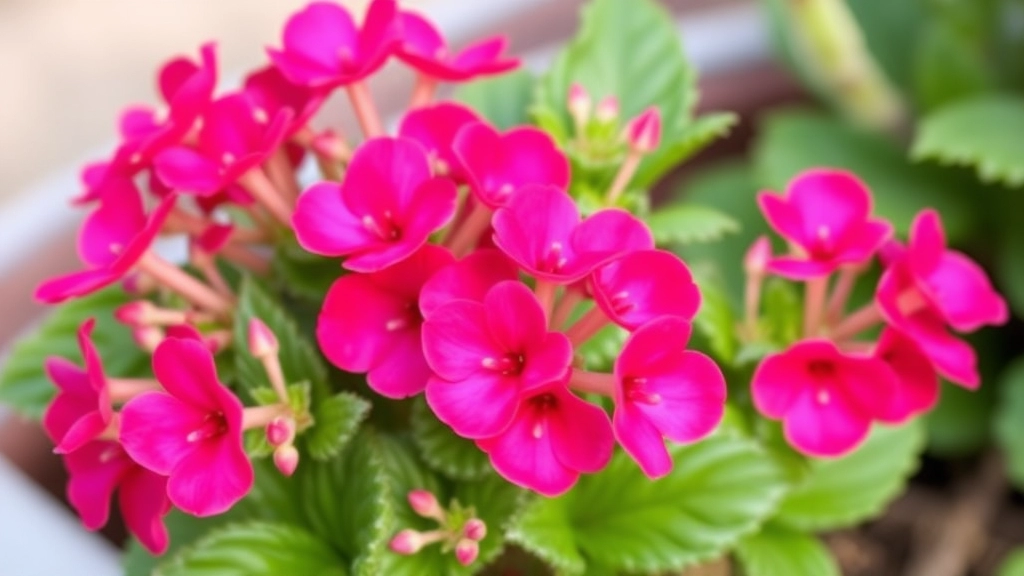
So, you’ve got your beautiful Hot Pink Kalanchoe thriving, but what if I told you there are some pesky little critters and diseases that could ruin your day?
Pests to Watch Out For:
- Mealybugs
- Look for white, cottony spots on your plant.
- They suck the sap and can cause stunted growth.
- Spider Mites
- Tiny and often invisible, but you might notice fine webbing.
- They thrive in dry conditions and can cause yellowing leaves.
- Aphids
- Small and green, they cluster on new growth.
- They can distort leaves and flowers.
- Scale Insects
- Look for small, brown bumps on stems and leaves.
- They can weaken your plant significantly.
Diseases to Be Aware Of:
- Root Rot
- Often caused by overwatering.
- Look for mushy roots and a foul smell.
- Powdery Mildew
- A white, powdery substance on leaves.
- Usually a sign of high humidity and poor air circulation.
- Leaf Spot
- Dark spots on leaves can indicate fungal infections.
- Often linked to overwatering or poor drainage.
Prevention Tips:
- Good Air Circulation
- Keep your plant in a spot with plenty of airflow.
- Proper Watering
- Allow the soil to dry out completely between waterings.
- Regular Inspection
- Check your plant weekly for any signs of pests or diseases.
- Cleanliness
- Wipe down leaves to remove dust and potential pests.
When it comes to keeping your Hot Pink Kalanchoe thriving, repotting and soil choice are crucial elements. You might be wondering, âWhen should I repot my Kalanchoe?â or âWhat type of soil is best for succulents?â Let’s explore these concerns to ensure your plant flourishes.
Repotting is essential for the health of your Kalanchoe, particularly when:
– **Roots are visible at the drainage holes**: This indicates your plant is root-bound and needs more space.
– **Soil appears degraded**: If the soil looks compacted or discoloured, it’s time for a change.
– **You notice stunted growth**: A lack of progress may signify that your plant requires fresh soil.
Kalanchoe thrives in well-draining soil. Here’s what to look for:
– **Cactus or succulent potting mix**: These mixes are specifically formulated to allow excess water to escape, preventing root rot.
– **DIY mix**: Combine equal parts of potting soil, coarse sand, and perlite for optimal drainage.
**Tip**: Always ensure your pot has drainage holes to further protect against overwatering.
Repotting Steps:
1. **Choose the right time**: Spring is the best season to repot your Kalanchoe as it prepares for new growth.
2. **Gently remove the plant**: Carefully take your Kalanchoe out of its current pot, being cautious not to damage the roots.
3. **Inspect the roots**: Trim any dead or mushy roots with sterilised scissors.
4. **Place in new soil**: Put your Kalanchoe in the new pot with fresh soil, ensuring it sits at the same depth as before.
5. **Water lightly**: After repotting, give it a small amount of water to help settle the soil.
By following these steps, you’ll set your [Hot Pink Kalanchoe](https://planthq.org/kalanchoe-succulent-pink-care-growth-propagation-guide/) up for success in its new home. For more comprehensive insights, you can explore our [Complete Care Guide for Pink Butterflies Kalanchoe](https://planthq.org/complete-care-guide-for-pink-butterflies-kalanchoe/).
How to Encourage Reblooming in Kalanchoe
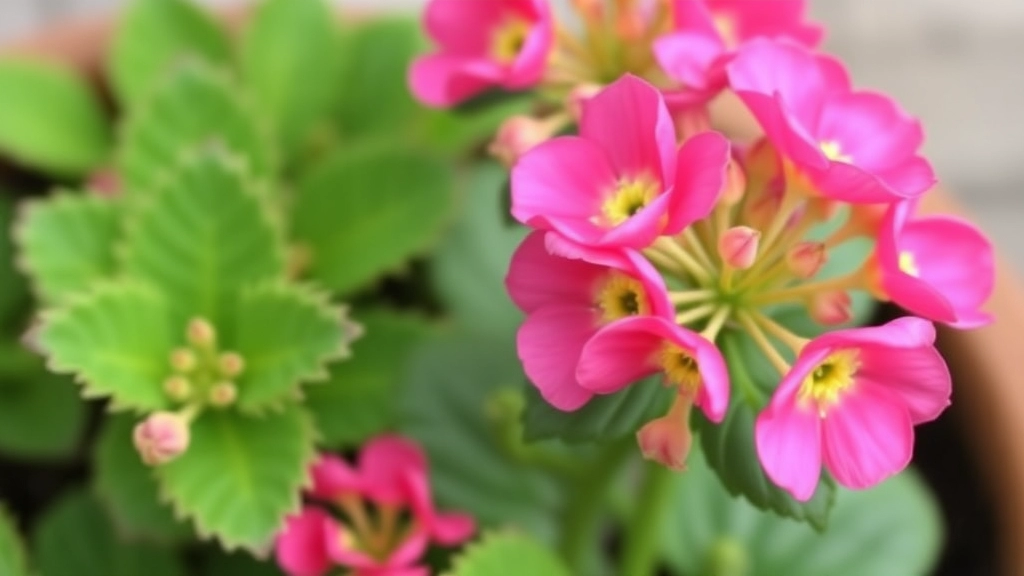
So, you’ve got a stunning Hot Pink Kalanchoe, and now you’re wondering how to coax those vibrant blooms back to life.
It’s a common concern for plant lovers—how to get your Kalanchoe to flower again after its initial show.
Here’s how to encourage reblooming:
- Light Exposure: Make sure your Kalanchoe gets plenty of bright, indirect sunlight. Too little light can hinder blooming.
- Watering Routine: After the blooming period, reduce watering. Let the soil dry out completely between waterings. This stress can trigger new flower growth.
- Pruning: Once the flowers fade, trim back the spent blooms and any leggy growth. This helps the plant focus its energy on producing new flowers.
- Fertilization: Use a balanced, water-soluble fertiliser every 4-6 weeks during the growing season. Look for fertilizers high in phosphorus to promote flowering.
- Temperature Control: Kalanchoes thrive in warmer conditions. Keeping them in a temperature range of 18-24°C (65-75°F) can encourage more blooms.
- Rest Period: After blooming, give your Kalanchoe a rest period of about 6 weeks. Reduce light and water during this time. This helps the plant recharge for its next blooming cycle.
By following these simple tips, you can keep your Hot Pink Kalanchoe looking vibrant and full of life.
Propagation Methods: Grow Your Own Kalanchoe
If you’ve enjoyed caring for your Hot Pink Kalanchoe, you might be wondering how to expand your collection or share the joy with friends. Propagating Kalanchoe is not only rewarding, but it’s also a straightforward process that can lead to beautiful new plants.
Common Propagation Methods
- Leaf Cuttings
- Select a healthy leaf from your Kalanchoe.
- Cut the leaf at the base using a clean, sharp knife.
- Allow the cut end to dry for a few days to form a callus.
- Place the leaf in well-draining soil and water lightly.
- Keep the soil slightly moist and watch for new growth.
- Stem Cuttings
- Choose a healthy stem with several leaves.
- Cut a 3-4 inch segment from the stem.
- Let it dry for a couple of days until the cut end calluses.
- Plant it in a pot with well-draining soil.
- Water sparingly until roots develop.
- Offsets
- Look for small offsets or âpupsâ at the base of the plant.
- Gently separate them from the main plant.
- Replant them in their own pots with suitable soil.
- Water lightly until established.
Tips for Successful Propagation
- Timing: Spring is the best time to propagate Kalanchoe, as the plant is in its active growth phase.
- Humidity: Keep the cuttings in a humid environment to encourage root development.
- Light: Place cuttings in bright, indirect light for optimal growth.
By following these methods, you can easily propagate your Hot Pink Kalanchoe and enjoy the satisfaction of watching new plants thrive. For more detailed instructions, you might find our Kalanchoe Daigremontiana Propagation Guide useful. Additionally, if you’re interested in other propagation techniques, check out our guide on Kalanchoe Synsepala Propagation.
Popular Uses of Hot Pink Kalanchoe in Home Décor

So, you’ve got your stunning Hot Pink Kalanchoe, and now you’re wondering how to showcase it in your living space?
Let’s dive into some creative ways to incorporate this vibrant plant into your home décor.
1. Table Centerpieces
Hot Pink Kalanchoe makes for a striking centerpiece on dining tables or coffee tables.
- Mix & Match: Pair it with other succulents for a textured look.
- Seasonal Touches: Add seasonal decorations like candles or fairy lights for extra flair.
2. Window Sills
These beauties thrive in bright light, making window sills the perfect spot.
- Layering: Use different heights and sizes of pots for a dynamic effect.
- Sunshine Boost: They’ll soak up the sun and brighten your space.
3. Hanging Planters
Got limited space? Hanging planters are a game-changer.
- Visual Interest: Suspend them at varying heights for an eye-catching display.
- Easy Care: They’re easy to water and maintain, plus they free up surface space.
4. Office Décor
Add some life to your workspace with a Hot Pink Kalanchoe.
- Mood Booster: The vibrant colour can help lift your spirits during long work hours.
- Low Maintenance: Perfect for busy professionals who might forget to water regularly.
5. Gifts and Celebrations
Hot Pink Kalanchoe also makes a fantastic gift.
- Personal Touch: A plant is a thoughtful gesture for birthdays, housewarmings, or just because.
- Long-lasting: Unlike cut flowers, this beauty can thrive for years with proper care.
6. Creative Arrangements
Try grouping your Kalanchoe with other plants.
- Colour Contrast: Pair it with greens or whites for a stunning visual contrast.
- Themed Displays: Create a themed arrangement based on seasons or colour schemes.
Where to Buy Hot Pink Kalanchoe Plants
Finding the perfect Hot Pink Kalanchoe can be a challenge, especially if you want a healthy, vibrant plant. You might be wondering where to look for these stunning succulents.
Local Nurseries and Garden Centres
Local nurseries and garden centres often stock a variety of Kalanchoe plants, including the popular Hot Pink variety. Visiting in person allows you to inspect the plants for health and vitality.
- Pros:
- Ability to see the plant before buying
- Support local businesses
- Expert advice from staff
Online Plant Retailers
If you prefer shopping from home, there are numerous online retailers that offer Hot Pink Kalanchoe. Websites like Etsy, Amazon, and dedicated plant shops can deliver directly to your door.
- Pros:
- Wider selection
- Convenience of home delivery
- Often includes customer reviews
Specialty Plant Shops
Some specialty shops focus solely on succulents and cacti. These stores usually have knowledgeable staff who can guide you in selecting the best Hot Pink Kalanchoe for your needs.
- Pros:
- Expert advice
- Unique varieties not found elsewhere
- Community events and workshops
Local Plant Swaps or Markets
Check out local plant swaps or farmers’ markets. You might find a fellow plant lover willing to trade or sell their Hot Pink Kalanchoe.
So, you’ve got your stunning Hot Pink Kalanchoe and you’re thinking, âWhat can I pair it with to really make it pop?â
Choosing the right companion plants can elevate your Kalanchoe arrangement, creating a vibrant and harmonious display. Here are some fantastic options that not only look great together but also thrive in similar conditions.
### Perfect Pairings for Kalanchoe
– **Aloe Vera**: This succulent is a classic choice. Its fleshy leaves complement the Kalanchoe’s blooms beautifully, and both enjoy bright light.
– **Echeveria**: With its rosette shape and various colours, Echeveria adds texture and contrast. They’re both low-maintenance, making them a great match.
– **Sedum**: These hardy succulents come in many varieties. Their trailing nature can soften the edges of your arrangement, creating a lovely cascading effect.
– **Haworthia**: Known for their striking patterns, Haworthia plants thrive in similar conditions as Kalanchoe. Plus, they add an interesting visual element.
– **Zamioculcas zamiifolia (ZZ Plant)**: If you want something a bit different, ZZ plants are resilient and can handle low light, balancing out the brighter Kalanchoe.
### Things to Keep in Mind
– **Light Requirements**: Ensure all plants have similar light needs. Most succulents prefer bright, indirect sunlight.
– **Watering Needs**: Group plants with similar watering habits. Overwatering can be a killer for succulents.
– **Soil Type**: A well-draining soil mix is essential for both Kalanchoe and its companions.
Creating a beautiful arrangement doesn’t have to be a headache. For more specific tips on caring for your Kalanchoe, check out our [essential Kalanchoe care tips for summer success](https://planthq.org/essential-kalanchoe-care-tips-for-summer-success/) or learn how to [deadhead Kalanchoe flowers for continuous blooming](https://planthq.org/how-to-deadhead-kalanchoe-flowers-for-continuous-blooming/).
FAQs about Hot Pink Kalanchoe
What are the best growing conditions for a Hot Pink Kalanchoe indoors?
Hot Pink Kalanchoe thrives in bright, indirect light and temperatures between 15°C and 25°C. It prefers dry air and good air circulation. A well-draining pot, like a terracotta pot, is essential to prevent excess moisture.
How often should I water my Hot Pink Kalanchoe?
Water your Kalanchoe every two to three weeks, but always check the top inch of the soil first. If it’s dry, it’s time to water. During the growing season (spring and summer), you may need to water more frequently, about once a week. In autumn and winter, reduce watering to once every three weeks.
What are common pests and diseases that affect Hot Pink Kalanchoe?
Common pests include mealybugs, spider mites, aphids, and scale insects. Diseases to watch out for are root rot, powdery mildew, and leaf spot. Regular inspection, proper watering, good air circulation, and cleanliness can help prevent these issues.
How can I encourage reblooming in my Hot Pink Kalanchoe?
To encourage reblooming, ensure your plant gets plenty of bright, indirect sunlight. Reduce watering after the blooming period and let the soil dry out completely between waterings. Prune spent blooms and leggy growth, use a balanced fertilizer every 4-6 weeks during the growing season, and keep the plant in warmer conditions (18-24°C). Give your plant a rest period of about 6 weeks with reduced light and water.
How can I incorporate Hot Pink Kalanchoe into my home décor?
Hot Pink Kalanchoe can be used in various ways to enhance your home décor:
- As table centerpieces, paired with other succulents or seasonal decorations.
- On window sills, using different heights and sizes of pots.
- In hanging planters, suspended at varying heights.
- As office décor to boost mood and add a low-maintenance touch.
- As gifts for birthdays, housewarmings, or other celebrations.
- In creative arrangements with other plants for colour contrast or themed displays.
References
-
How to Grow Kalanchoe Plants Indoors
-
Kalanchoe Plant Care: Tips For Growing Kalanchoe Plants
-
Kalanchoe: How to Care for Kalanchoe Plants
